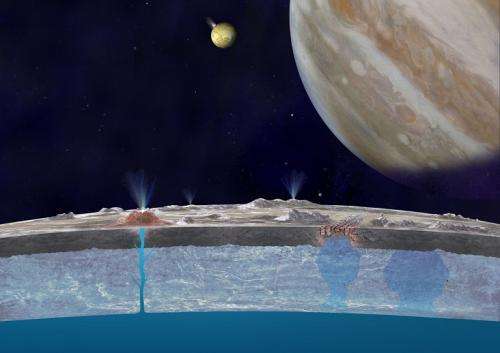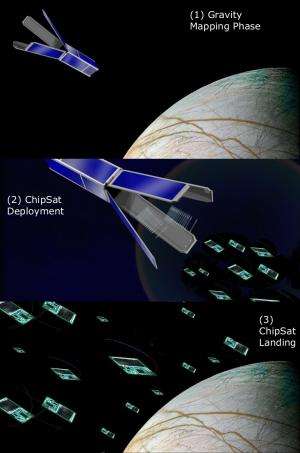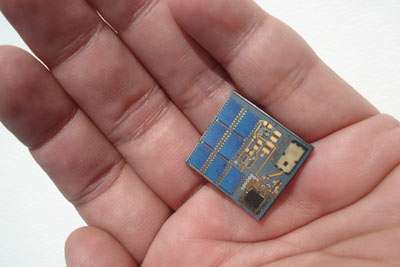Swarm of tiny spacecraft to explore Europa's surface with rapid response

A small spacecraft carrying a swarm of "chipsats" the size of postage stamps could someday explore Jupiter's icy moon, Europa. NASA has funded early development of the unusual mission idea as it looks toward future space exploration of planets and moons that may contain both water and extraterrestrial life.
The Europa mission proposal aims to create a gravitational map of the moon's icy surface that many researchers suspect hides an alien ocean beneath. That map would then allow the mission's "mothership"—a cubesat the size of several Rubik's cubes stuck together—to deploy possibly hundreds of tiny chipsats to regions of Europa's surface where liquid water is coming out. The "two missions in one" concept—using cheap, expendable chipsats that represent tiny spacecraft-on-a-chip systems—could allow the mission to react quickly to new events happening on Europa's surface, unlike more expensive missions sent to the moon and Mars in the past that just carried one large lander or robotic rover.
"Let's say we go to Europa, measure the moon's gravity using the spacecraft's quantum inertial sensors, and we find a cool new place with liquid water coming out of surface or near surface," said Brett Streetman, principal investigator at the Draper Laboratory in Cambridge, Mass. "Instead of waiting for a new mission to be funded so we can bring a robotic lander the next time, now we can respond to things happening on the planet and send chipsats down right away."
NASA's Innovative Advanced Concepts (NIAC) Program recently awarded $100,000 to the Draper Laboratory, a not-for-profit research and development laboratory, to work out the concept for how such a mission could explore Europa and other moons or planets on the fly.
Each chipsat may only carry a few sensors capable of detecting the presence of certain chemical elements, but the lack of moving parts means the chipsats have a good chance of surviving impact upon landing on Europa's surface. Streetman and John West, program manager at the Draper Laboratory, have been refining the chipsat idea alongside Mason Peck, a mechanical and aerospace professor at Cornell University and former chief technologist for NASA. Draper Laboratory has also been developing a new gravitational sensor that could create a density map of Europa which would reveal the moon's internal structure and differentiate icy or liquid parts of the moon based on their density. NASA previously used a similar gravitational sensor concept in its GRAIL mission that involved looking at the moon's gravitational effects on the distance between twin spacecraft orbiting as a pair.

But instead of using two spacecraft, the Draper Laboratory developed cold atom sensing as a technology capable of acting as a gravitational sensor. Cold atom sensing uses a combination of magnets and laser beams to trap atoms and then measure the effect of gravity on the atom's positions.
"We have a tabletop model working in the lab, but to my knowledge no one has deployed this technology in any field use that we know of," West said.
Such technology could fit within a spacecraft made of several cubesats—small cubic satellites about 4 inches long on each side. The Draper Laboratory team estimates that their Europa mission mothership could range in size from three to six cubesats.
Most cubesats launch as low-cost missions that piggyback on the rocket rides of bigger missions. But the proposed Europa mission would likely need its own dedicated rocket to launch it on the proper trajectory to reach Jupiter's moon. Still, Draper Laboratory hopes that using low-cost cubesats could make for a cheaper space mission than past planetary missions costing hundreds of millions or billions of dollars.

If Draper Laboratory can come up with a feasible mission proposal, the researchers could also apply for a second phase of NIAC funding from NASA worth about $400,000. The lab does not plan to produce spacecraft hardware during this first phase, but it does already have sample devices and prototypes for both the chipsats and the gravitational sensor.
researchers with the possibility of liquid water lurking beneath the frozen surface. They hope their miniaturized mission's flexibility will speed up the process of surveying and then exploring the moon's mysteries sometime in the next decade or two.

"Every time we go there we find cool stuff we didn't expect to find," Streetman said. "And we always leave with more questions than answers."
This proposal isn't the only idea to consider smaller robotic explorers for Europa. Another concept from NASA's Jet Propulsion Laboratory in California and Uppsala University in Sweden suggested using a small robotic submarine the size of two soda cans to look for signs of alien life in Europa's ocean.
Source: Astrobio.net
This story is republished courtesy of NASA's Astrobiology Magazine. Explore the Earth and beyond at www.astrobio.net .













.jpg)






